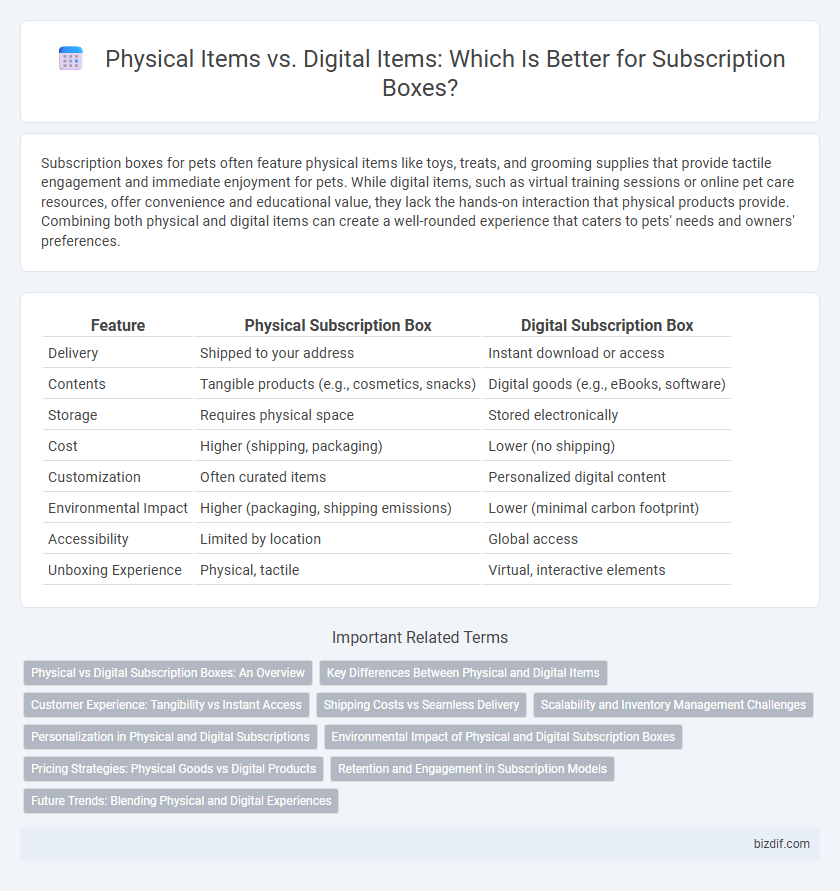Subscription boxes for pets often feature physical items like toys, treats, and grooming supplies that provide tactile engagement and immediate enjoyment for pets. While digital items, such as virtual training sessions or online pet care resources, offer convenience and educational value, they lack the hands-on interaction that physical products provide. Combining both physical and digital items can create a well-rounded experience that caters to pets' needs and owners' preferences.
Table of Comparison
| Feature | Physical Subscription Box | Digital Subscription Box |
|---|---|---|
| Delivery | Shipped to your address | Instant download or access |
| Contents | Tangible products (e.g., cosmetics, snacks) | Digital goods (e.g., eBooks, software) |
| Storage | Requires physical space | Stored electronically |
| Cost | Higher (shipping, packaging) | Lower (no shipping) |
| Customization | Often curated items | Personalized digital content |
| Environmental Impact | Higher (packaging, shipping emissions) | Lower (minimal carbon footprint) |
| Accessibility | Limited by location | Global access |
| Unboxing Experience | Physical, tactile | Virtual, interactive elements |
Physical vs Digital Subscription Boxes: An Overview
Physical subscription boxes offer tangible products such as beauty samples, gourmet snacks, or fitness gear that enhance user experience through sensory engagement and unboxing excitement. Digital subscription boxes provide instant access to software, e-books, or streaming content, catering to convenience and space-saving advantages. The choice between physical and digital subscription boxes depends on user preferences for tactile interaction versus immediate digital delivery.
Key Differences Between Physical and Digital Items
Physical items in subscription boxes offer tangible goods such as beauty products, snacks, or apparel that subscribers can see, touch, and use immediately, often providing a sensory experience and collectible value. Digital items include downloadable content, e-books, software, or exclusive online access, delivering instant convenience and eliminating shipping costs or delays. Key differences lie in delivery method, user interaction, storage requirements, and the potential for reuse or resale, where physical items require inventory and logistics management, and digital items depend on digital rights management and platform compatibility.
Customer Experience: Tangibility vs Instant Access
Subscription boxes offering physical items provide customers with a tangible, sensory experience that enhances perceived value through unboxing and hands-on interaction. Digital subscription offerings deliver instant access, convenience, and immediate gratification without shipping delays or packaging waste. The choice between physical and digital items significantly impacts customer satisfaction, with physical products emphasizing touch and novelty, while digital items prioritize speed and accessibility.
Shipping Costs vs Seamless Delivery
Physical subscription boxes often incur higher shipping costs due to packaging, weight, and logistics, impacting overall profitability. Digital subscription services provide seamless delivery with instant access and zero shipping fees, enhancing customer convenience. Businesses balance physical tangibility with cost efficiency by optimizing shipping strategies or leveraging digital alternatives.
Scalability and Inventory Management Challenges
Physical subscription boxes require complex inventory management due to storage, packaging, and shipping logistics, which limit scalability and increase operational costs. Digital subscription services eliminate physical inventory constraints, allowing for rapid scale and immediate updates without supply chain delays. Managing physical items demands forecasting demand accurately to avoid overstock or shortages, whereas digital items offer streamlined distribution and minimal risk of inventory mismanagement.
Personalization in Physical and Digital Subscriptions
Personalization in subscription boxes enhances user experience by tailoring both physical and digital items to individual preferences. Physical subscription boxes offer tangible, curated products that can be customized based on recipient demographics, interests, and past purchase behavior, delivering a sensory and memorable unboxing experience. Digital subscriptions leverage data analytics and AI to personalize content, recommendations, and access, providing dynamic and instantly scalable customization without the constraints of physical inventory.
Environmental Impact of Physical and Digital Subscription Boxes
Physical subscription boxes generate considerable environmental impact due to packaging waste, transportation emissions, and resource consumption involved in producing tangible goods. Digital subscription boxes, by contrast, minimize carbon footprints by eliminating shipping and reducing material use but still depend on data centers whose energy consumption varies based on sustainable practices. Choosing digital subscriptions can significantly lower ecological damage, especially when providers utilize renewable energy and optimize server efficiency.
Pricing Strategies: Physical Goods vs Digital Products
Pricing strategies for subscription boxes differ significantly between physical goods and digital products due to production and distribution costs. Physical items typically require higher base prices to cover manufacturing, shipping, and inventory management, whereas digital products benefit from lower marginal costs, enabling more flexible pricing tiers and subscriptions. Digital subscriptions often leverage scalable models with minimal incremental expenses, while physical boxes must factor in logistics and material expenses to maintain profitability.
Retention and Engagement in Subscription Models
Physical items in subscription boxes drive higher retention and engagement by delivering tangible value that fosters emotional connections and repeated anticipation. Digital items enhance engagement through instant access and personalized content, yet often struggle with long-term retention without physical reinforcement. Hybrid models combining both physical and digital offerings maximize subscriber loyalty by appealing to diverse preferences and continually refreshing the subscription experience.
Future Trends: Blending Physical and Digital Experiences
Subscription boxes are evolving to blend physical and digital items, creating immersive experiences that engage multiple senses. Integrating augmented reality (AR) and QR codes with physical products enhances user interaction and personalizes content delivery. Future trends emphasize hybrid offerings that combine tactile goods with dynamic digital features to elevate customer engagement and satisfaction.
Physical items vs Digital items Infographic

 bizdif.com
bizdif.com